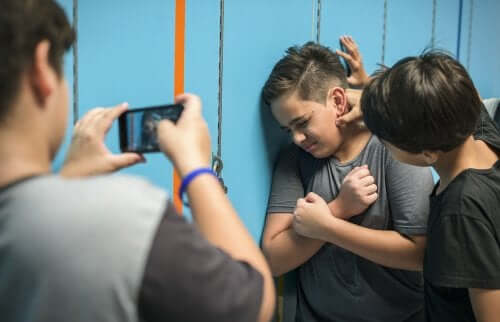How to Detect Cyberbullying in Adolescents


Written and verified by the psychologist María Alejandra Castro Arbeláez
Cyberbullying is a social problem that’s becoming more and more frequent and serious these days. Currently, the world of social media is becoming more relevant for youth. Therefore, it’s important to pay close attention to the signs in order to detect cyberbullying in adolescents.
What is cyberbullying?
Cyberbullying among adolescents consists of the use of ITCs in order to cause hurt or damage to a peer. Bullying that takes place on social media has taken on a dimension that’s completely different from more traditional forms of bullying.
Cyberbullying is considered to be a type of indirect assault, of which there are three different types:
- Harassment or the sending of images and videos that incriminate or humiliate the victim.
- Exclusion or the spreading of negative comments to produce an expansive response.
- Manipulation or using information one has found and spreading it in an inappropriate way among the members of diverse social media platforms.

“People who repeatedly attack your confidence and self-esteem are quite aware of your potential, even if you are not.”
– Wayne Gerard Trotman –
Considerations regarding cyberbullying in adolescents
The EMICI (Multidisciplinary team of investigation about cyberbullying) has developed a protocol that involves a series of relevant considerations when it comes to bullying via ITCs.
1. Cyberbullying scenarios among teens
The first of these considerations addresses the transcendence of virtual scenarios versus more traditional settings. These virtual scenarios can invade the privacy and personal space of victims to a much greater scale. As a result, they can have long-term effects on adolescents in every area of their personal lives.
2. The anonymity of cyberbullying
This second consideration focuses on anonymity, which is one of the most relevant characteristics of cybernetic bullying. Internet anonymity offers a profound benefit to bullies who can carry on with their actions without revealing their identity.
3. The place where cyberbullying occurs
Third, the EMICI takes into consideration the private or public nature of the aggression. In other words, the aggression is private if it takes place in a setting where only the bully and the victim can see it (ie. chats, private messages, emails, etc). The aggression is public when others can also witness and get involved (ie. Instagram feeds, Youtube videos, etc).
4. The roles of cyberbullying
Other relevant considerations are the different roles that cyberbullying involves. According to the EMICI, there are six different roles:
- Aggressor.
- Reinforcer of the aggressor.
- Helper to the aggressor.
- Defender of the victim.
- Outside participant.
- Victim.
How to detect cyberbullying in adolescents?
Recognizing that your child may be suffering from cyberbullying can be a difficult task. This is especially true when it comes to adolescents, as this is a stage when children become more reserved regarding their private lives.
In fact, at first, detecting cyberbullying among teens when it’s still occurring is almost impossible. However, little by little, small signs begin to appear that, as parents, we must take into account and watch out for at all times.

Signs of cyberbullying in adolescents
First of all, parents must pay attention to their children’s use of cell phones, computers, and other digital devices. This includes observing any changes in regards to the time children spend on these devices.
What’s more, cyberbullying can produce mood changes after the use of the internet. Or, perhaps your child has started accessing social media when you’re not around.
Whatever the case may be, talking to your children about cyberbullying – even before you suspect anything – is an important part of prevention and detection.
Cyberbullying is a social problem that’s becoming more and more frequent and serious these days. Currently, the world of social media is becoming more relevant for youth. Therefore, it’s important to pay close attention to the signs in order to detect cyberbullying in adolescents.
What is cyberbullying?
Cyberbullying among adolescents consists of the use of ITCs in order to cause hurt or damage to a peer. Bullying that takes place on social media has taken on a dimension that’s completely different from more traditional forms of bullying.
Cyberbullying is considered to be a type of indirect assault, of which there are three different types:
- Harassment or the sending of images and videos that incriminate or humiliate the victim.
- Exclusion or the spreading of negative comments to produce an expansive response.
- Manipulation or using information one has found and spreading it in an inappropriate way among the members of diverse social media platforms.

“People who repeatedly attack your confidence and self-esteem are quite aware of your potential, even if you are not.”
– Wayne Gerard Trotman –
Considerations regarding cyberbullying in adolescents
The EMICI (Multidisciplinary team of investigation about cyberbullying) has developed a protocol that involves a series of relevant considerations when it comes to bullying via ITCs.
1. Cyberbullying scenarios among teens
The first of these considerations addresses the transcendence of virtual scenarios versus more traditional settings. These virtual scenarios can invade the privacy and personal space of victims to a much greater scale. As a result, they can have long-term effects on adolescents in every area of their personal lives.
2. The anonymity of cyberbullying
This second consideration focuses on anonymity, which is one of the most relevant characteristics of cybernetic bullying. Internet anonymity offers a profound benefit to bullies who can carry on with their actions without revealing their identity.
3. The place where cyberbullying occurs
Third, the EMICI takes into consideration the private or public nature of the aggression. In other words, the aggression is private if it takes place in a setting where only the bully and the victim can see it (ie. chats, private messages, emails, etc). The aggression is public when others can also witness and get involved (ie. Instagram feeds, Youtube videos, etc).
4. The roles of cyberbullying
Other relevant considerations are the different roles that cyberbullying involves. According to the EMICI, there are six different roles:
- Aggressor.
- Reinforcer of the aggressor.
- Helper to the aggressor.
- Defender of the victim.
- Outside participant.
- Victim.
How to detect cyberbullying in adolescents?
Recognizing that your child may be suffering from cyberbullying can be a difficult task. This is especially true when it comes to adolescents, as this is a stage when children become more reserved regarding their private lives.
In fact, at first, detecting cyberbullying among teens when it’s still occurring is almost impossible. However, little by little, small signs begin to appear that, as parents, we must take into account and watch out for at all times.

Signs of cyberbullying in adolescents
First of all, parents must pay attention to their children’s use of cell phones, computers, and other digital devices. This includes observing any changes in regards to the time children spend on these devices.
What’s more, cyberbullying can produce mood changes after the use of the internet. Or, perhaps your child has started accessing social media when you’re not around.
Whatever the case may be, talking to your children about cyberbullying – even before you suspect anything – is an important part of prevention and detection.
All cited sources were thoroughly reviewed by our team to ensure their quality, reliability, currency, and validity. The bibliography of this article was considered reliable and of academic or scientific accuracy.
- Del Rey, R., Flores, J., Garmendia, M., Martínez, G., Ortega, R. y Tejerina, O. (EMICI) (2010). Protocolo de Actuación Escolar ante el Ciberbullying.
This text is provided for informational purposes only and does not replace consultation with a professional. If in doubt, consult your specialist.








